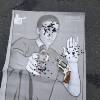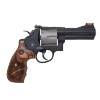In case I missed seeing it, in the previously-posted replies, be sure to hold really high on the grip. It can feel “natural” for some of us to hold rather low, especially with small revolvers, but that lets the muzzle flip far worse. It is simple leverage, at work. See my avatar photo, how I am holding high, on my GP100. This principle will reduce muzzle flip, with any revolver of conventional design, with its bore axis located higher than the shooter’s hand.
I learned my lesson with my first SP101, in the early or mid-Nineties, holding too low. Shooting Mags was painful, so I sold or traded it away. In 1997, after reading or hearing something about gripping small-frame revolvers, I tried another SP101, and paid special attention to holding high on the grip, with much better results, even with the harsh 125-grain duty-type loads, and 180-grain hunting loads. (Not that I generally carried these stoutest loads in the SP101, but I wanted to know what would happen, if the heavier stuff was used during an emergency reload.)
I have yet to try an LCR-series revolver, so, cannot address any specific issues with the factory grip options, or after-market grips.
One thing about grips, in general, is that by age 56, I definitely preferred that a handgun grip reach all the way to make firm contact with the “heel bone” part of my hand, especially if shooting with my gimpier right hand.
By age 41, or so, I stopped wanting to shoot .38 J-Frames, of the ~14-ounce Airweight construction, with anything more powerful than standard-pressure .38 Specials. Now, at 61, target wadcutters are my choice, with my Airweight, and I avoid shooting it right-handed.




